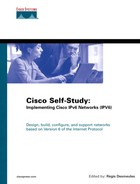Configuration Exercise: Configuring an IPv6 Network Using Cisco Routers
Complete the following exercise to configure IPv6 on a network to practice skills learned in this chapter.
NOTE
Configuration Exercises allow you to practice your skills and knowledge by configuring IPv6 on a Cisco router using commands presented in this chapter. In the exercise presented here, only one router with multiple Fast Ethernet interfaces provides IPv6 connectivity to nodes on a network. This exercise assumes that you have minimal experience with the command-line interface (CLI) and that you can download a new Cisco IOS Software from the Cisco website.
Objectives
In the following exercise, you will complete the following tasks:
Install a new Cisco IOS Software with IPv6 support on a Cisco router. The filename of the new image is c2600-is-mz.2001120.
Enable IPv6 on the Cisco router.
Assign IPv6 addresses to interfaces.
Verify interfaces and addresses assigned.
Network Architecture for Tasks 1 and 2
Figure 2-22 shows a basic network architecture used for Tasks 1 and 2.
Figure 2-22. Network Architecture for Enabling IPv6 on a Router

Command List
In this configuration exercise, you will use the commands shown in Table 2-29. Refer to this list during the exercise.
| Command | Description |
|---|---|
| copy running-config startup-config | Saves a current configuration to NVRAM. |
| copy tftp flash | Installs a new IOS on a router using a TFTP server. |
| hostname name | Configures the router's name. |
| interface interface-type interface-number | Specifies an interface type and interface number. |
| ip address ip-address network-mask | Configures an IPv4 address to an interface. |
| ip cef | Enables CEF for IPv4. |
| ipv6 cef | Enables CEF for IPv6. |
| ipv6 unicast-routing | Enables IPv6 traffic forwarding. |
| ipv6 address ipv6-address/prefix-length | Configures an IPv6 static address with a prefix length. |
| no ip address ip-address network-mask | Disables an IPv4 address. |
| show interface interface-type interface-number | Displays general information about the interface. |
| show ipv6 | Displays general information about IPv6 support on a router. |
| show ipv6 interface interface-type interface-number | Displays the IPv6 configuration applied to an interface type and interface number. |
Task 1: Basic Router Setup and Installing New Cisco IOS Software with IPv6 Support
Configure a basic setup on Router A to install the new IOS on the router with IPv6 support. The TFTP server is connected to the same link-layer network as the Fast Ethernet (FE) 0/0 interface. The TFTP server can only be reached over IPv4 using 192.168.1.1 as the IPv4 address.
Task 2: Enable IPv6 on the Router and Configure Static Addresses
Complete the following steps:
Step 1. | Enter the command to enable IPv6 traffic forwarding on the router to forward unicast IPv6 packets between interfaces. Then enable CEFv6 in the router. What commands will you use? RouterA#conf t RouterA(config)#ipv6 unicast-routing RouterA(config)#ip cef RouterA(config)#ipv6 cef RouterA(config)#exit | |||||||||
Step 2. | Verify the hardware address (Ethernet MAC address) of all interfaces on Router A, and calculate the link-local address of each interface. Fill in the following table. What command gets the hardware address of each interface?
RouterA#show interface fastEthernet 0/0 FastEthernet0/0 is up, line protocol is up Hardware is AmdFE, address is 0050.3ee4.4c00 (bia 0050.3ee4.4c00) MTU 1500 bytes, BW 10000 Kbit, DLY 1000 usec, reliability 255/255, txload 1/255, rxload 1/255 Encapsulation ARPA, loopback not set Keepalive set (10 sec) Half-duplex, 10Mb/s, 100BaseTX/FX ARP type: ARPA, ARP Timeout 04:00:00 Last input 00:03:01, output 00:00:07, output hang never Last clearing of "show interface" counters never Queueing strategy: fifo <data omitted> .. RouterA#show interface fastEthernet 0/1 FastEthernet0/1 is administratively down, line protocol is down Hardware is AmdFE, address is 0050.3ee4.4c01 (bia 0050.3ee4.4c01) MTU 1500 bytes, BW 100000 Kbit, DLY 100 usec, reliability 255/255, txload 1/255, rxload 1/255 Encapsulation ARPA, loopback not set Keepalive set (10 sec) Auto-duplex, Auto Speed, 100BaseTX/FX ARP type: ARPA, ARP Timeout 04:00:00 Last input never, output never, output hang never Last clearing of "show interface" counters never Queueing strategy: fifo | |||||||||
Step 3. | Suppose that the router acts as an IPv6 host. Configure one static unicast IPv6 address per interface. Use the addresses in the following table to configure the router's interfaces. What command assigns one IPv6 address per interface?
RouterA#conf t Enter configuration commands, one per line. End with CNTL/Z. RouterA(config)#interface fastEthernet 0/0 RouterA(config-if)#ipv6 address fec0:0:0:1001::1/128 RouterA(config-if)#interface fastEthernet 0/1 RouterA(config-if)#ipv6 address fec0:0:0:1002::1/128 RouterA(config)#exit | |||||||||
Step 4. | Verify the static and link-local addresses of each interface. What command displays IPv6 addresses used on an interface? Then compare the link-local addresses with those calculated in Step 2. Are they similar? RouterA#show ipv6 interface fastEthernet 0/0 FastEthernet0/0 is up, line protocol is up IPv6 is enabled, link-local address is FE80::250:3EFF:FEE4:4C00 Global unicast address(es): FEC0:0:0:1001::1, subnet is FEC0:0:0:1001::/128 Joined group address(es): FF02::1 FF02::2 FF02::1:FF00:1 FF02::1:FFE4:4C00 MTU is 1500 bytes ICMP error messages limited to one every 100 milliseconds ICMP redirects are enabled ND DAD is enabled, number of DAD attempts: 1 ND reachable time is 30000 milliseconds ND advertised reachable time is 0 milliseconds ND advertised retransmit interval is 0 milliseconds ND router advertisements are sent every 200 seconds ND router advertisements live for 1800 seconds Hosts use stateless autoconfig for addresses. RouterA#show ipv6 interface fastEthernet 0/1 FastEthernet0/1 is administratively down, line protocol is up IPv6 is enabled, link-local address is FE80::250:3EFF:FEE4:4C01 Global unicast address(es): FEC0:0:0:1002::1, subnet is FEC0:0:0:1002::/128 Joined group address(es): FF02::1 FF02::2 FF02::1:FF00:1 FF02::1:FFE4:4C01 MTU is 1500 bytes ICMP error messages limited to one every 100 milliseconds ICMP redirects are enabled ND DAD is enabled, number of DAD attempts: 1 ND reachable time is 30000 milliseconds ND advertised reachable time is 0 milliseconds ND advertised retransmit interval is 0 milliseconds ND router advertisements are sent every 200 seconds ND router advertisements live for 1800 seconds Hosts use stateless autoconfig for addresses. | |||||||||
Step 5. | Save the current configuration to NVRAM: RouterA#copy running-config startup-config
Destination filename [startup-config]?
Building configuration...
|
